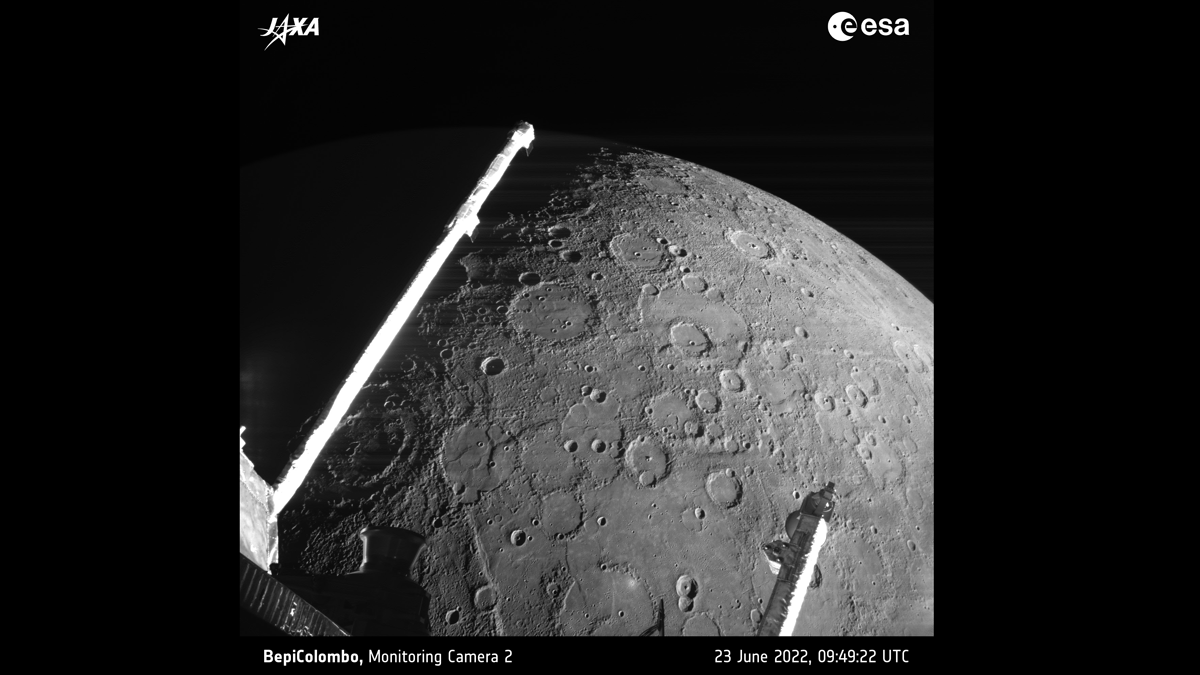In a few days, the BepiColombo mission is scheduled to fly past Mercury for the third time on its way to an orbital insertion around the planet. The mission, a joint effort of the European Space Agency (ESA) and the Japan Aerospace Exploration Agency (JAXA), will make its closest approach at 19:34 Universal Time on 19 June (3:34 p.m. Eastern on 20 June). The maneuver will bring it within 240 kilometers of the planet’s surface.
“The flybys around Mercury, plus the flybys at Venus and Earth at the beginning of our cruise phase, are an essential part of our mission to be able to put our spacecraft in an orbit around Mercury,” said Johannes Benkhoff, BepiColombo project scientist at ESA.
Why Fly on By?
Since it launched in 2018, BepiColombo has completed a flyby of Earth, two flybys of Venus, and two flybys of Mercury. Each encounter borrows a small bit of gravity from the planet and uses that energy to alter the speed or trajectory of the spacecraft. “One needs a lot of energy to bring a spacecraft into an orbit around Mercury,” Benkhoff explained. An onboard propulsion system contributes a little, he said, but “most of the energy is obtained from our flybys.”
Despite it being the smallest planet, entering orbit around Mercury requires more energy than, for example, entering orbit around Mars because of its proximity to the Sun, whose gravity drags spacecraft off course. A lot of the energy gained through the multiple gravity assists will go toward resisting the Sun’s pull.
“All flybys must succeed to insert BepiColombo into Mercury’s orbit.”
“All flybys must succeed to insert BepiColombo into Mercury’s orbit,” said Go Murakami, BepiColombo project scientist at JAXA. The spacecraft will complete six Mercury flybys in total. Missing one would be devastating to the mission, Benkhoff said, but at this point “the operation is kind of routine since we have done it already a few times.”
Science Opportunities
Two other spacecraft—NASA missions Mariner 10 and MESSENGER (Mercury Surface, Space Environment, Geochemistry, and Ranging)—have visited Mercury, and each led to significant discoveries about the planet’s magnetic field, composition, structure, and evolution. BepiColombo scientists aim to study the structure, atmosphere, and magnetosphere of Mercury as well as sample the environment of the inner solar system.
“We still need to wait 2.5 years,” Murakami said, “but we can get science observation data of Mercury [during] this time.”
While it is in its cruise configuration, not all of BepiColombo’s instruments are available to take scientific measurements. However, some instruments could still collect data on the magnetic, plasma, and particle environment around the craft before, during, and after each flyby in regions that won’t be accessible during its orbital phase, Benkhoff said. BepiColombo’s earlier passes through Mercury’s magnetosphere highlighted the constantly changing conditions around the planet.
“We witnessed the huge variability of Mercury’s magnetosphere, which dynamically responds to the ever-changing solar wind.”
“The most remarkable thing to me is that the data look totally different between the first and second flybys even though the flyby trajectories are very similar to each other,” said Yuki Harada, an assistant professor at Kyoto University in Japan. Harada used data from each flyby to characterize the low-energy ions in Mercury’s magnetosphere. “Just from these two flybys, we witnessed the huge variability of Mercury’s magnetosphere, which dynamically responds to the ever-changing solar wind.”
The first science results from the upcoming flyby will be published on 20 June. This and the prior two Mercury encounters trace very similar paths around the planet, Murakami explained, and so they will provide excellent opportunities to examine how the space environment near the planet changes over time.
Harada is interested in how Mercury’s magnetosphere responds to the changing solar wind environment. “Will the third flyby resemble the first one or the second one? Or will it show completely new phenomena?” he said. “Comprehensive measurements by BepiColombo will help us elucidate the mysterious workings of Mercury’s magnetosphere.”
—Kimberly M. S. Cartier (@AstroKimCartier), Staff Writer



